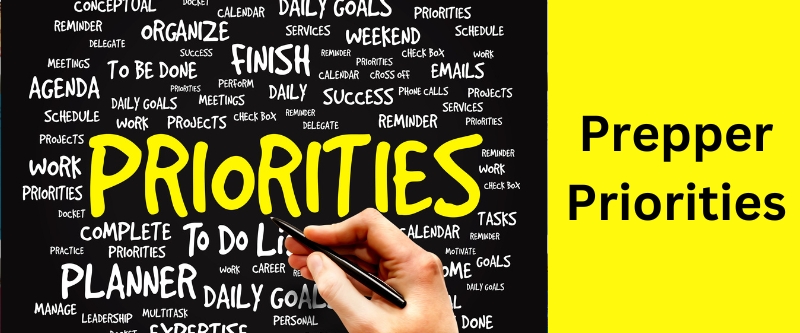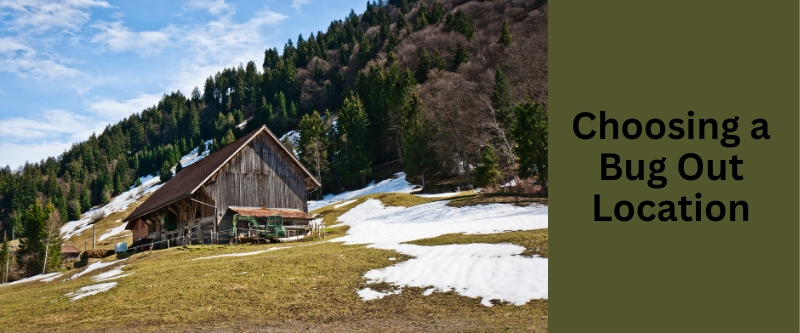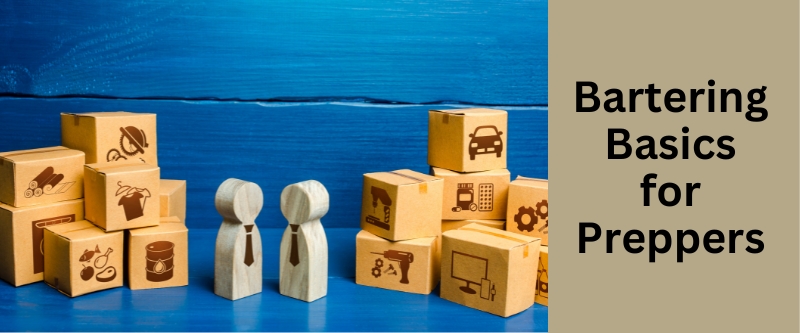Table of Contents
From the Probable to the Possible
Introduction: The Risk Continuum
The prepping world posits emergency scenarios ranging from from the mundane to the cataclysmic. That is from a temporary power outage at one end of the range to complete societal breakdown at the other.
But how do you prioritize, especially if you are just starting out? It is not realistic to plan for it all at once.
So you have to strike a balance between preparing for the most probable events right away, while not neglecting the extreme possibilities down the road. You need to do a risk analysis.
There is actually quite a long continuum of risk simply expressed by the words “may, might, could,” and we have laid out the various possibilties below.
Once you understand the risks, you are better able to orient yourself into the resources, knowledge and skills you need to meet the risk.
The Prepper’s Continuum
So the prepper has to do a risk analysis across the continuum of the various scenarios. And these range from the most likely to the least likely. It is obviously best to prepare thoroughly for the most likely emergency scenarios and then move on progressively to the least likely (but still possible) scenarios
Starting with the Basics
Every prepper begins with the most immediate and likely scenarios. These are events that we hear about in the news regularly – power outages, natural disasters, and local disruptions. Preparing for these situations is not just practical; it’s essential. It sets the foundation for all future preparedness efforts.
Moving to Intermediate Scenarios
Once the basics are covered, preppers often shift their focus to intermediate scenarios. These might include extended power outages, economic downturns, or regional disasters. While they occur less frequently than the basic scenarios, their impact can be more prolonged and widespread.
Advanced Prepping for Rare Events
Advanced prepping involves preparing for events that are less likely but have a more significant impact. This could range from major natural disasters that affect an entire coast to pandemics or significant political upheavals.
The Extreme End of the Spectrum
At the far end of the continuum lie the extreme, hair-on-fire scenarios. These are the least likely, but they’re also the ones that capture the most attention. Think of societal collapses, EMP attacks, or global catastrophes. While they’re less probable, being prepared for them ensures that a prepper is ready for anything.
Balancing Probability with Preparedness
The key for every prepper is to strike a balance. It’s about understanding the probability of each scenario and allocating resources, time, and effort accordingly. While you should prepare for extreme events, it shouldn’t come at the cost of neglecting more immediate and likely scenarios.
Let’s look at the effects of these scenarios in a little more detail.
The Effects of These Scenarios
All of these scenarios can have effects in common. What mainly distinguishes them is their duration, which can range from mere hours to years.
Power Outages
One of the most common foreseeable disruptions is a power outage resulting from storms, grid failures, or even human error. Preparing for them involves:
- Having alternative light sources.
- Backup power options.
- Ensuring electronic devices can be charged,
- Non-electric heating options like wood-burning stoves or propane heaters for colder climates.
Water Supply Disruptions
Causes could be infrastructure failures, contamination, or a natural disaster. Preparation:
- Store a minimum of one gallon of water per person per day for at least three days.
- Be equipped to purify water through filtration, boiling, and purification tablets.
Transportation Breakdowns
Causes could be strikes, fuel shortages, or natural disasters. Preparation:
- Keep a bug-out bag in your vehicle.
- Maintain a full gas tank when possible.
- Familiarize yourself with alternative routes and modes of transportation.
Communication Failures
Causes could be network overloads, infrastructure damage, or cyber-attacks. Preparation:
- Have a battery-operated radio to receive news updates.
- Satellite phones and ham radios.
Natural Disasters
Depending on your location, this could be hurricanes, earthquakes, wildfires, or floods. You need to understand the risks inherent to your area and prepare. This could mean:
- Having an evacuation plan,
- Securing your home. This could mean creating flood barriers, securing furniture against earthquakes, or maintaining a defensible space against wildfires.
- Stockpiling specific supplies.
- Understand the specific threats to your region and prepare accordingly.
Financial Challenges
Economic downturns, bank failures, job losses, or unexpected expenses can strike without warning. Financial preparedness involves:
- Having an emergency fund.
- Keeping a stash of cash in small denominations.
- Diversifying income sources.
- Understanding basic financial management.
- Diversifying investments to include tangible assets like gold or silver.
Health Emergencies
Accidents, illnesses, or even global pandemics can disrupt normal life. Being prepared means:
- Having a well-stocked first-aid kit
- Understanding basic medical procedures
- Having a plan for medical emergencies.
By focusing on these common scenarios, you ensure that you’re well-prepared for the majority of challenges you might face. Once you’ve secured your preparedness in these areas, you can then expand to consider less likely, but potentially more severe, scenarios.
Less Likely SHTF Scenarios
The less likely scenarios involve long-term disruptions that can have profound impacts on our way of life. These scenarios can last from several weeks to years, demanding not just resources but adaptability, resilience, and a strong community spirit.
Preparing for these scenarios requires all of the preparations you have already made for the short term events described above, and then some. Let’s look at them.
EMP Attacks or Solar Flares
These have the potential to fry electronic circuits, rendering most modern technology useless. This includes taking down the electric grid. Preparation:
- Store essential electronics in Faraday cages or EMP cloth.
- Learn to navigate without GPS, communicate without phones, and live without modern conveniences.
- Renewable energy sources like solar panels or wind turbines.
- Learn to preserve food without refrigeration,
- Develop skills like candle-making and fire-starting.
Nuclear or Biological Warfare
This can lead to widespread devastation, radiation, and disease. Preparation:
- Understand the basics of radiation protection.
- Stock up on potassium iodide tablets, hazmat suits, and gas masks.
- Learn about decontamination procedures and quarantine protocols.
Asteroid Impact or Supervolcano Eruption
These natural cataclysmic events can lead to “nuclear winters,” where ash clouds block sunlight, leading to global cooling. Preparation:
- Stockpile food and water for extended periods.
- Learn to grow crops in low-light conditions, like mushrooms or certain algae.
- Understand how to purify air and water in ash-filled environments.
Prolonged Economic Collapse
This can be caused by hyperinflation, debt crises, or systemic financial sector failures that lead to prolonged economic downturns. Preparation:
- Diversify your assets.
- Investments in tangible goods like precious metals, real estate,
- Learn and be prepared to barter.
- Grow your own food.e
- Reduce debts.
- Build a network of like-minded individuals for mutual support.
Complete Societal Collapse with Civil Unrest
A combination of factors, from economic to environmental, can lead to the complete breakdown of societal structures. Preparation: Focus on self-sufficiency.
- Build strong community ties,
- Develop barter systems,
- Master skills like blacksmithing, herbal medicine, and manual farming.
- Strengthen home security.
- Prepare to defend yourself and family from desperate mobs.
- Relocate to safer areas.
Global Pandemic with High Mortality
Here a disease more lethal than any previous pandemic sweeps across the globe, causing societal breakdown due to high mortality rates. Preparation:
- The usual pandemic preparations.
- Consider remote locations for retreat.
- Understand long-term quarantine procedures.
- Develop self-sufficiency skills to minimize outside contact.
- Stock up on essential medical supplies, including over-the-counter medications, prescription drugs, and protective gear.
Being Forced Into the Wilderness
In extreme cases, one might need to retreat to the wilderness for survival, living off the land and away from societal challenges. Preparation:
- Master bushcraft skills.
- Learn about edible plants and hunting.
- Understand how to build shelters and purify natural water sources.
Assessing the Risks and Setting Priorities
Preparing for these scenarios is daunting on its face. However, the prepper’s philosophy is not about succumbing to fear but about empowerment. By preparing for the worst, we hope for the best.
However, once we understand the nature of the risks that preppers face, we are better able to assess them and plan to meet them.
You will see from our analysis above that we have placed a forced retreat into the wilderness as being at the far end of the risk spectrum. It is not something that should be ignored but, in our opinion, everything that goes into becoming a survivalist is at a lower priority than getting all of our other prepping ducks in a row.
However, that is just our opinion. There are many of a survivalist inclination who would head into the woods at a moment’s notice. Everyone must make his own assessment. But no matter your risk assessment and your inclination, you have to start somewhere.
But remember, your risk assessment must remain fluid. The threat landscape is ever-evolving. From emerging global challenges to shifts in local dynamics, staying updated is crucial. Regularly revisiting and adjusting your prepping priorities ensures you’re always a step ahead.
Tailoring Your Preparedness Plan to Your Priorities
Every individual’s journey into the world of prepping is unique. While there are general guidelines and best practices, the most effective preparedness plan is one tailored to your assessment of risk, specific circumstances, needs, and goals. Here’s how to conduct a personal assessment to customize your approach.
Identify Your Strengths and Weaknesses
Begin by taking stock of your current skills and resources. Maybe you’re an expert gardener, or perhaps you have a medical background. Conversely, you might realize you lack knowledge in areas like basic first aid or home repairs. Recognizing these strengths and weaknesses helps prioritize learning and resource allocation.
Assess Your Environment
Your geographical location plays a significant role in your prepping strategy. Someone living in a coastal area would have different concerns than someone in a mountainous region. Understand the natural disasters common to your area, the local resources available, and the community’s general preparedness mindset.
Financial Situation
Your economic status will influence your prepping approach. While it’s ideal to have a year’s worth of supplies, it might not be feasible for everyone. Understand your budget, prioritize essential items, and consider cost-effective alternatives.
Health and Physical Capabilities
If you or a family member has a specific medical condition, it’s crucial to factor that into your preparedness plan. This could mean stockpiling certain medications, having specialized medical equipment, or even tailoring your physical preparedness routines to accommodate any limitations.
Family and Community Dynamics
Are you prepping just for yourself, or do you have a family to consider? Children, elderly family members, or pets will influence your preparedness strategy. Additionally, understanding the preparedness level of your broader community can offer insights into potential collaboration or areas where you might need to be more self-reliant.
Set Clear Goals
With your assessment in hand, set clear, achievable goals. These could range from learning a new skill each month, reaching a certain stockpile level, or even community-based objectives like starting a neighborhood watch program.
By conducting a thorough personal assessment, you ensure that your preparedness plan is not only effective but also aligned with your specific situation and goals. It provides a roadmap, guiding your efforts and ensuring that you remain focused and efficient in your prepping journey.
Adopting an Approach to Prepping
At its core, prepping is about anticipation. It’s a proactive approach to life, ensuring that when challenges arise, you’re not caught off guard. But what does it truly mean to be a prepper?
At its core, prepping is about anticipation and preparation. It’s a proactive approach to life, ensuring that when challenges arise, you’re not caught off guard. But what does it truly mean to be a prepper?
- Mindset Over Material: While many associate prepping with stockpiling supplies, it’s more about the mindset. It’s the ability to foresee potential challenges and have strategies in place to navigate them. This mindset extends beyond physical supplies to encompass skills, knowledge, and mental resilience.
- Holistic Approach: Prepping isn’t just about survival; it’s about thriving. This means considering all aspects of life, from physical health and financial stability to emotional well-being and community ties. A well-rounded prepper is prepared not just to survive a crisis but to come out of it stronger.
- Continuous Learning: The world is dynamic, and so are its challenges. A true prepper is always learning, adapting, and evolving. This could mean staying updated with global events, learning new survival skills, or understanding the latest technological advancements that could aid in preparedness.
- Simplicity is Key: Especially for those new to prepping, the sheer volume of information and recommendations can be overwhelming. But remember, the essence of prepping is simplicity. Start with the basics, understand your immediate needs, and gradually expand your preparedness horizons.
- Customization: There’s no one-size-fits-all in prepping. Your geographical location, family needs, health conditions, and even personal preferences play a crucial role in shaping your prepping strategy. Tailor your approach to fit your unique circumstances.
In essence, understanding the basics of prepping is about recognizing its multidimensional nature. It’s a blend of mindset, skills, knowledge, and resources, all tailored to fit your unique situation.
Everyday Basics of Prepping
Everyday preparedness is the foundation of a solid prepping strategy. Before diving into more complex scenarios, it’s essential to have the basics covered. These are the preparations that will serve you well in everyday life and during more common disruptions.
- Water and Food: At the very least, aim to have a three-day supply of water (one gallon per person per day) and non-perishable food items. This can tide you over during short-term power outages or other minor disruptions. Remember, in many situations, the tap might not be safe to drink from, so having a reliable water filter can be a game-changer.
- Financial Preparedness: Aim to have at least three to six months’ worth of living expenses saved up. Limit debt and make sure insurances are adequate. Lean into tangible assets.
- First Aid: A well-stocked first aid kit is non-negotiable. Ensure it contains bandages, antiseptics, pain relievers, and any prescription medications you or your family might need. Familiarize yourself with basic first aid procedures—knowing how to treat a wound or recognize signs of certain illnesses can make a significant difference.
- Power Alternatives: Power outages are among the most common disruptions. Having alternative light and power sources, such as flashlights, candles, or even a portable generator, can make these situations more manageable.
- Communication: In today’s digital age, we’re heavily reliant on our phones and the internet. Consider having a battery-operated radio to stay updated on news and alerts. Also, establish a communication plan with your family, so you know how to get in touch if separated.
- Essential Documents: Keep a folder with all crucial documents, such as identification, insurance policies, medical records, and bank account details. In an emergency, having these easily accessible can save time and reduce stress.
- Basic Tools and Repair Kits: From fixing a leaky faucet to mending a torn piece of clothing, having basic tools and repair kits can be invaluable. This includes things like a multi-tool, sewing kit, duct tape, and perhaps even a basic set of mechanic tools.
- Personal Protection: While we all hope never to face a situation where our safety is threatened, it’s wise to have some form of personal protection. This could be pepper spray, a whistle, or even self-defense training.
Everyday preparedness is about enhancing your resilience in the face of life’s smaller challenges. By ensuring you’re well-equipped to handle these, you’re also laying a strong foundation for tackling more significant challenges should they arise.
Skill Development: Beyond Stockpiling Supplies
While having supplies is essential, skills are invaluable. From basic first aid to knowing how to purify water, skill development ensures you’re not solely dependent on your stockpile. Engage in local workshops, online courses, and community training sessions to continuously upgrade your skill set.
While having a well-stocked pantry and a plethora of supplies is essential, true preparedness goes beyond tangible items. It delves into the realm of skills and knowledge, which, once acquired, can’t be taken away and often prove invaluable in various scenarios. Here’s a look at the importance of skill development in the prepping journey:
Self-Reliance and Basic Survival Skills
- Foraging: Learn to identify edible plants, fruits, and mushrooms in your region. This skill can supplement your food supply in emergencies.
- Fishing & Hunting: Acquiring skills in fishing and hunting can provide a fresh source of protein when other food sources are scarce.
- Basic Mechanics: Understand the basics of repairing common household items or vehicles. This can save time, money, and stress during disruptions.
Medical Knowledge
- First Aid: Familiarize yourself with basic first aid procedures, from dressing wounds to performing CPR.
- Herbal Remedies: Learn about local herbs that can be used for medicinal purposes, offering natural alternatives when modern medicine isn’t available.
- Mental Health: Understand the basics of managing stress, anxiety, and other mental health challenges that can arise in crisis situations.
Homesteading Skills
- Gardening: Grow your own food, understanding the seasons, soil types, and pest control methods.
- Preservation: Learn methods like canning, drying, and fermentation to preserve food for longer durations.
- Animal Husbandry: If space allows, consider raising chickens, goats, or bees, and understand their care requirements.
Communications Skills
- Signaling: Learn methods to signal for help, from using mirrors to creating smoke signals.
- Radio Operation: Understand the basics of operating ham radios or walkie-talkies, ensuring you can communicate when conventional methods fail.
- Non-Verbal Communication: Develop skills in non-verbal communication, like hand signals, which can be useful in situations where silence is crucial.
Defensive Skills
- Self-Defense: Engage in self-defense training, ensuring you can protect yourself and your loved ones.
- Firearm Safety: If you choose to own firearms, understand their safe operation, maintenance, and storage.
- Tactical Training: Familiarize yourself with basic tactical movements and strategies, enhancing your security in various scenarios.
Skill development transforms you from a passive prepper to an active one. It empowers you to adapt, innovate, and thrive, no matter the circumstances. While supplies can run out, skills endure, making them one of the most potent tools in a prepper’s arsenal.
Conclusion
Prepping is a journey, not a destination. It’s about being proactive, staying informed, and building a life that’s resilient. Whether you’re prepping for a two-day power outage or a wilderness survival scenario, the principles remain the same: anticipate, prepare, and adapt.
However, that said, the journey has a beginning. And that starts with the assessment of risk and your place in it.
FAQs
Why is prioritizing prepper scenarios important?
Prioritizing allows you to focus on the most immediate and likely threats first, ensuring that you’re prepared for common emergencies. As you progress, you can then address less likely scenarios, ensuring a comprehensive preparedness plan without feeling overwhelmed.
How often should I revisit my prepping priorities? Regularly. As global and local dynamics change, so should your prepping strategies.
Is there such a thing as over prepping? Yes. While being prepared is essential, it’s crucial to strike a balance and ensure you’re not neglecting other aspects of life.
Can I ever be “fully prepared”?
Preparedness is a journey, not a destination. While you can achieve a high level of readiness, it’s essential to remain adaptable and open to learning. New challenges, tools, and information will always emerge.
How do I balance preparing for short-term vs. long-term scenarios?
Start with short-term preparations, as these scenarios are more likely to occur. Once you’re confident in your ability to handle immediate threats, gradually expand your focus to include long-term sustainability and self-sufficiency.
How can I avoid feeling overwhelmed with all the potential scenarios?
Break your preparedness journey into manageable steps. Focus on one aspect at a time, celebrate small victories, and remember that every bit of preparation makes you more resilient than before.





Leave a Reply